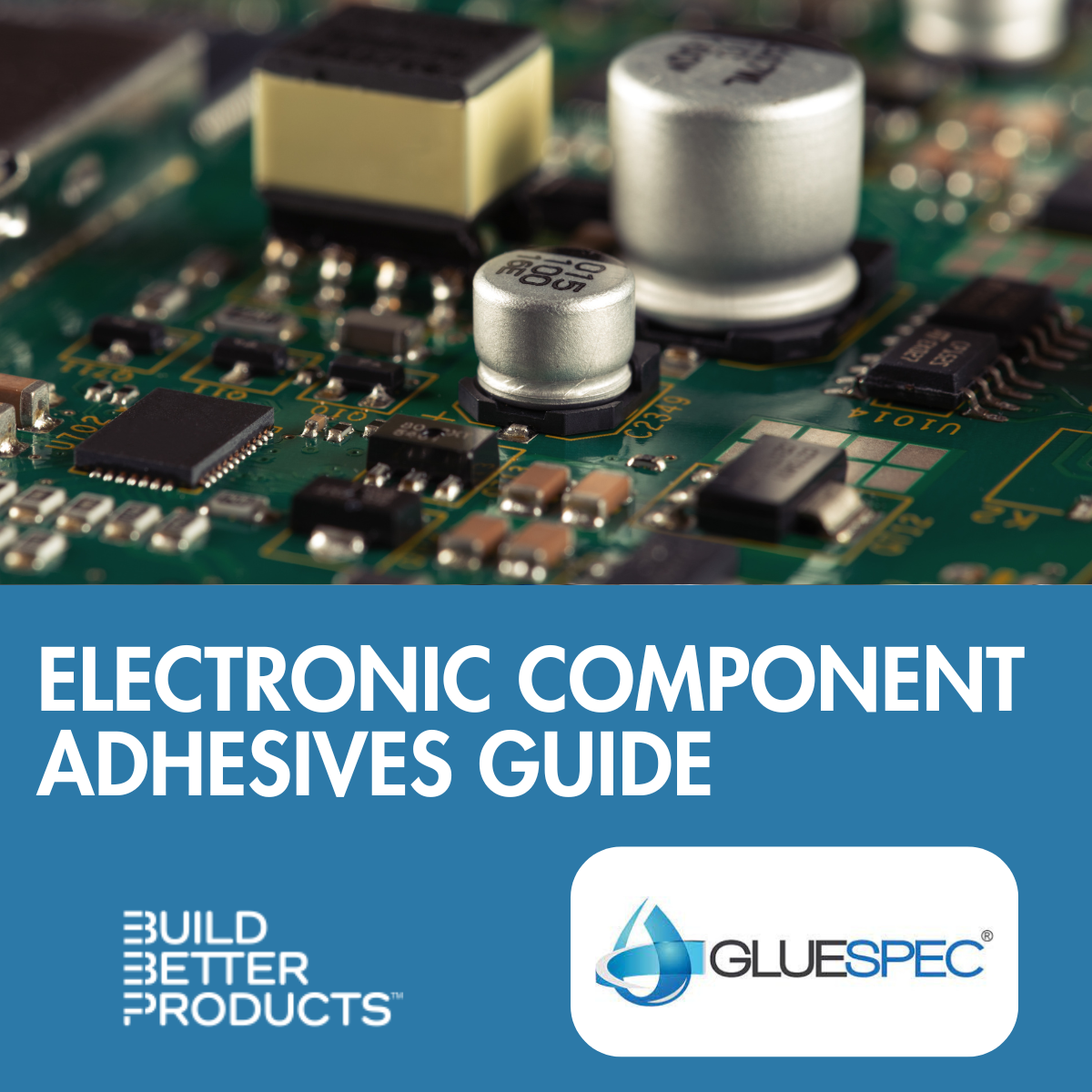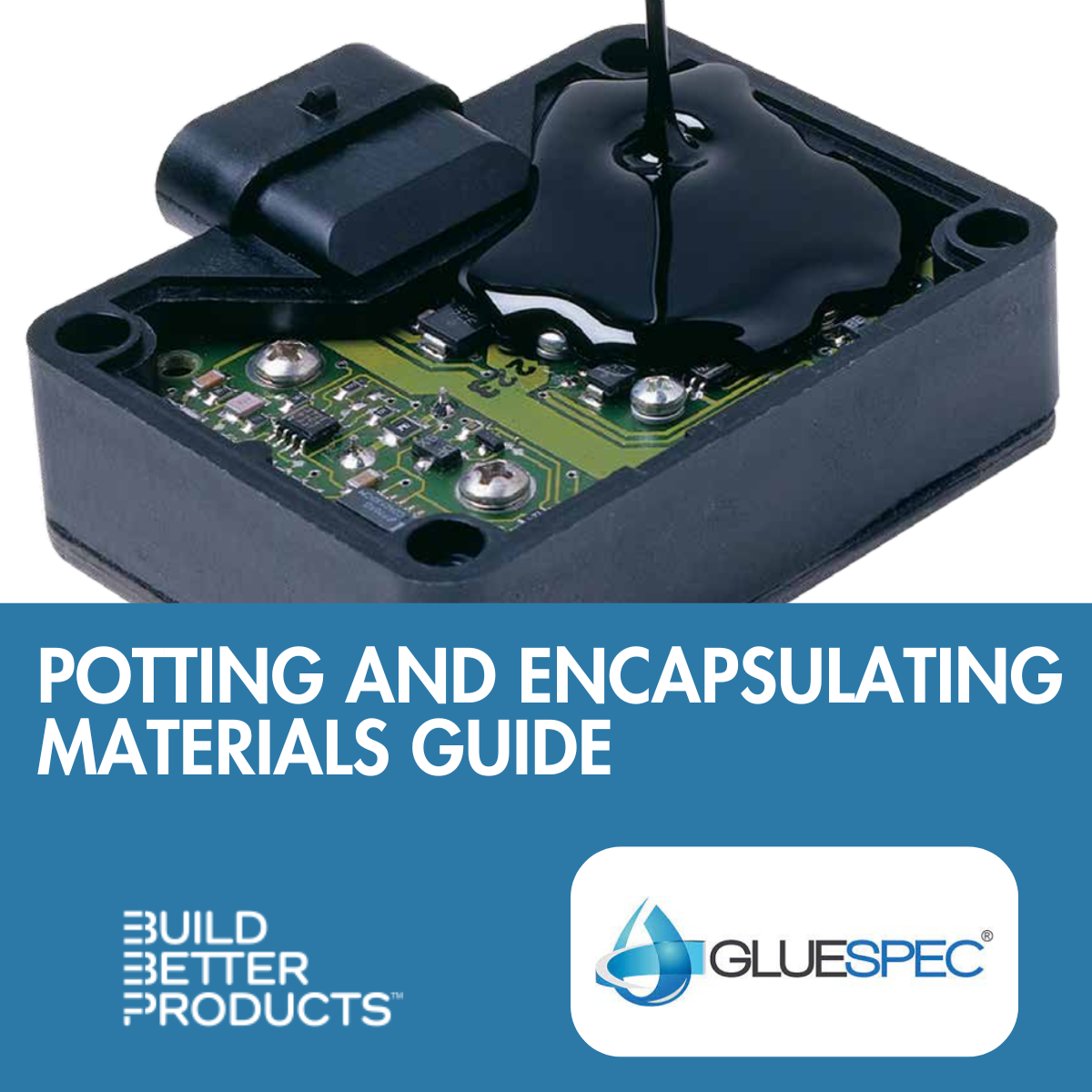

- Contributions by industrial experts with engineers in mind
- Focused on specialty-chemical material applications and selection
Knowledge Center
Thermal Adhesives Guide

Listen to This Article
Thermal adhesives bond components and help move or transfer heat. In the electronics industry, these thermally conductive materials are used for bonding heat sinks, passive heat exchangers that transfer the heat generated by electronic components to a fluid medium, typically air or a liquid coolant. They're also used with batteries in electric vehicles, LEDs, smart meters, and headlamps.
This guide explains what design engineers need to know about selecting thermal adhesives, a category of materials you’ll find on Gluespec.
Gluespec's comprehensive and quality-tested database of 35,000 adhesive materials includes the thermal adhesives that design engineers need. Along with technical data and key specifications, you'll find best practices and comparable materials. You can also view test method information on dozens of material properties and data points.
Table of Contents
Introduction
Types of Thermal Adhesives
Introduction
Thermal adhesives combine component bonding with thermal management. By eliminating the need for clips, screws, or rivets, they support smaller, lighter products. These themal management materials also conform to surfaces and fill the gaps between components and substrates.
Thermal Conductivity
Thermal conductivity (TC) is a numeric value that describes a material's ability to conduct heat. Thermal adhesives are not as thermally condutive as metal, but they have a higher thermal conductivity than air, which would otherwise fill the gaps between heat sources and heat sinks. To provide thermal conductivity, adhesive resins are filled with metallic or inorganic fillers.
Selection Considerations
In addition to thermal conductivity, design engineers need to consider a thermal adhesive's compatbility, or ability to bond with, specific types of substrates. Examples include metal, plastic, or glass. Form factor and chemistry are also important considerations during product selection. Products come as liquids, films, or tapes and have epoxy, silicone, acrylic, or polyurethane chemistries.
Types of Thermal Adhesives
Gluespec divides thermal component adhesives into three main categories and makes it easy to search for materials online. Within each category, you can search for products based on technical specifications for curing, bond strength, material resistance, thermal conductivity, and other properties, such as tensile strength and flame resistance.
The following sections describe each category of thermal adhesives in detail. You’ll also find links to technical resources with additional information, either in the Gluespec Knowledge Center or from other trusted resources.
Thermal Liquid Adhesives
Thermal liquid adhesives are flowable and support dispensing. Two-component (A/B) products require mixing, but one-part products do not. Design engineers can choose thermal adhesives that support primer-less adhesion and that come in low, high, or medium viscosities. Also available are thixotropic products that can be dispensed but will stay in place after they are applied. Self-leveling adhesives achieve a consistent height to promote more uniform heat dissipation.
There are two curing methods for thermal adhesives: heat cure and room-temperature cure. Heat-curing adhesives require the use of ovens and provide a high degree of process repeatability because of greater temperature control. Room temperature curing adhesives do not require ovens, which reduces energy expenses and supports sustainability initiatives. Curing is faster at higher temperatures, however, and that reduces work-in-process. Thermal liquid adhesives that can cure either with heat or at room temperature are also available.
Applications
Applications for thermal liquid adhesives include:
- Heat sinks
- Smart meters
- Displays
- Integrated circuits (ICs)
- Headlamps
Products
These are some of the thermal liquid adhesives you'll find on Gluespec.
 |
EP1200 Black from Resinlab is a two-part, liquid epoxy that is highled filled. It has a medium viscosity, high flexibility, and low CTE. |
 |
Dowsil 1-4173 Thermally Conductive Adhesive from Dow is a one-part, liquid silicone that cures with heat. It's flowable, self-leveling after dispensing, and has low surface tension. |
 |
Loctite Ablestick CT 5047-2 from Henkel is a two-part, heat-cured liquid that can also cure at room temperature. It is both thermally and electrically conductive. |
 |
TC-2810 from 3M is a two-part epoxy resin that is filled with boron nitride for good thermal conductivity. It is cream in color and has good gap-filling properties. |
Tech Specs
Here are some of the technical specifications for thermal liquid adhesives like Dow Dowsil 1-4173.
|
Type |
Spec |
Definition |
|
Cure |
Cure Time (min)
|
The length of time needed for something to fully cure |
|
Bond Strength |
Shear Strength (psi)
|
The ability of a material to resist forces that cause the material’s internal structure to slide against itself. |
|
Conductivity |
Dissipation Factor |
A measure of loss-rate of energy of a mode of oscillation (mechanical, electrical, or electromechanical) in a dissipative system |
|
Other Properties |
Specific Gravity |
The ratio of the density of a substance to the density of some substance (such as pure water) taken as a standard when both densities are obtained by weighing in air |
Resources
Here are some additional resources about thermal liquid adhesives.
- Thermally conductive adhesives in power supply manufacturing
- Designing the proper thermal management system into your high power electronics
- Finding the right chemistry to protect your printed circuit board components
Thermal Film Adhesives
Thermal film adhesives consist of a thin, thermally conductive adhesive layer and, sometimes, a carrier or backing that provides structural support and dimensional stability. Pressure-sensitive adhesives (PSAs) are typically used, but some thermal film adhesives are cured with heat or with both heat and pressure. Among PSA thermal film adhesives, the use of solvent-based systems is common, especially with acrylic or polyurethane chemistries. Because they have a consistent height, thermal film adhesives are inherently self-leveling so that heat is dissipated more evenly.
There are two main types of thermal film adhesives. The first consists of products that are thermally conductive but electrically insulating. The second consists of products that are both thermally conductive and electrically conductive. To achieve both types of conductivity, silver fillers are used. For high-volume manufacturing, sheets or rolls of thermal film adhesives can be die cut into specific shapes and then applied to substrates, either by hand or with automated equipment. Among their advantages, thermal film adhesives are less messy to apply and won’t spread beyond the desired footprint.
Applications
Applications for thermal film adhesives include:
- Heat sinks
- Metal backplanes
- Silicon wafers
- Electrical assemblies
- Dies and ICs
Products
These are some of the thermal film adhesives you'll find on Gluespec.
 |
TF T2781 F from Resin Designs is a high-performance film adhesive with a high thermal conductivity and a fast cure time. It adheres well to various substrates. |
 |
Loctite Ablestick ECF 550S from Henkel is designed for microelectronics applications. It is gray in color, cures with heat, and contains a silver filler. |
 |
Staystik 581 from Alpha Metals is a one-part, silver-filled product that can be used for die attachment and/or substrate attachment with chips. |
Tech Specs
Here are some of the technical specifications for thermal film adhesives like Henkel Loctite Ablestik CDF 200.
|
Type |
Spec |
Definition |
|
Cure |
Work/Pot Time (min)
|
The length of time in which multiple part coatings or paints can be applied to a substrate |
|
Bond Strength |
Shear Strength (psi)
|
The ability of a material to resist forces that cause the material’s internal structure to slide against itself. |
|
Conductivity |
Electrical Conductivity (mhos/cm) |
A property of materials that determines how well a given material will conduct electricity |
|
Other Properties |
Glass Transition Temperature (Tg) (°F) |
The temperature at which a polymer changes from a hard, glassy state to a soft, rubbery state |
Resources
Here are some additional resources about thermal film adhesives.
- Film Adhesive Applications and Handling Guide
- Guide to Using Epoxy Film Adhesives
- Measurement of Thin Film Thermal Conductivity
Thermal Tape Adhesives
Thermal tape adhesives have a thermally conductive PSA on one or both sides of a carrier or backing. Typically, the carrier is a foam material that also provides cushioning and compressibility. Thermal tape adhesives that use closed-cell foams are recommended for environmental sealing, but products with open-cell foams are used for vibration dampening instead. Thermal tape adhesives include a release liner, often coated with silicone, that protects the adhesive layer and is peeled back before use. Common color for these tapes include white, black, gray, and charcoal gray.
Like other types of thermal adhesives, heat transfer tapes come in a choice of adhesive chemistries. Typically, however, acrylic adhesives are used because they combine strong bonds with long-term aging and high-temperature resistance. These and other types of thermal tape adhesives can be removed cleanly and reworked without a significant loss of adhesion. For higher volume applications, thermally conductive tapes can be die cut from sheets or rolls and then applied to substrates. Among their advantages, thermal tape adhesives have a consistent height but are available in a range of thicknesses.
Applications
Applications for thermal tape adhesives include:
- Automotive dashboards
- Computers and printers
- Recessed lighting
- Aircraft lights
- Military electronics
Products
These are some of the thermal tape adhesives you'll find on Gluespec.
 |
Single-Coated Vinyl Foam Tape 4714 from 3M is made of a flexible, black, medium-density, closed-cell foam and has a PSA on one side. |
 |
Tacky Tape SM5127 from Schnee-Morehead (ITW) is compattible with most bagging films and is an ideal choice for use on composite tool surfaces. |
Tech Specs
Here are some of the technical specifications for thermal tape adhesives like 3M Single-Coated Vinyl Foam Tape 4714.
|
Type |
Spec |
Definition |
|
Cure |
Application Temperature (°F)
|
The temperature at the point the adhesive/tape is applied |
|
Bond Strength |
General Bond Strength (psi)
|
The amount of adhesion between the bonded substrates |
|
Conductivity |
Dielectric Strength (V/mil) |
The electrical strength of an insulating material |
|
Hardness |
Elongation % |
The process of becoming or making something longer, and often thinner |
Resources
Here are some additional resources about thermal tape adhesives.
- Thermal Tape as an Alternative for Heat Management
- Adhesive Tapes in the LED Industry
- Adhesive Tapes Play an Important Role in EV Assembly
Gluespec is Your Source for Thermal Adhesives
Gluespec’s comprehensive and quality-tested database of 35,000 adhesive materials includes the thermal adhesives that design engineers need. The materials and manufacturers in our database are not limited to specific suppliers, and data is quality-checked and updated as needed whenever new data sheets or product specifications are released.
If you need deep data on thermal adhesives and other materials, you’ll find what you’re looking for in our proprietary adhesives database. Along with technical data and key specifications, you’ll find best practices and comparable materials. Design engineers can also view test method information on dozens of material properties and data points.
Finally, Gluespec’s Advanced Search provides the tools you need to conduct deep filtering among all material properties. The result is a customized grid that contains materials and data points that are specific to your project. Save custom grids for quick access and share them, along with this Thermal Adhesives Guide, with your colleagues.






